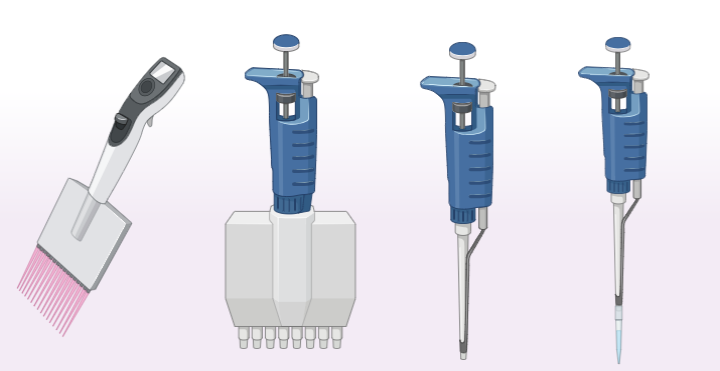Precision is not only necessary but also the cornerstone of accuracy and dependability in the wide field of scientific study and laboratory activity. The micropipette, a classic tool whose capacity to measure and transfer very small quantities of liquid with startling precision has completely changed the field of experimental science. The complexities, history, operation, kinds, and vital significance of the micropipette in contemporary laboratories are explained.
Fundamentally, a micropipette is an advanced instrument intended to precisely and accurately measure and transfer quantities ranging from a few microliters (μL) to several millilitres (mL). It has a plunger mechanism, a dial for volume control, an electronic digital display (optional), and a disposable tip that detaches and comes into contact with the liquid.

Methodology of working
The working concept of a micropipette is rather simple, yet it is cleverly implemented. Air displacement powers it. A predetermined amount of liquid is drawn up when the plunger is squeezed, creating a vacuum in the chamber above the disposable tip. The highly calibrated plunger mechanism, which makes sure that the volume of air expelled precisely matches the volume of liquid to be measured or transferred, provides measurement precision.
Parts of a micropipette
Understanding the components that make up a micropipette can help users operate them more effectively and maintain their precision.

1. Plunger Button
One essential part that is utilised to draw out and distribute liquid is the plunger button. The liquid is drawn up into the tip by carefully pressing it down and then released with another press. The plunger has two stops; a first stop that is used to pull up the proper amount of liquid, and a second, stronger stop that is sometimes referred to as the “blow-out stop” and is used to drive out any liquid that may still be in the tip.
2. Volume Adjustment Dial
The user can adjust the amount of liquid to be extracted using this dial. By turning the dial, you may modify the amount of liquid that is pulled up or discharged by altering the plunger’s travel distance. Micropipettes with customisable volumes have this functionality.
3. Digital Volume Display
This indicator, which is common on micropipettes with adjustable volume, indicates the volume that is now being adjusted, allowing the operator to precisely adjust the desired volume. In particular, the display is essential for accurate readings and preventing mistakes while adjusting the volume.
4. Tip Ejector Button
It is necessary to dispose of the tip after liquid transfer so as not to contaminate the user’s hands or the micropipette. This is made easier by the tip ejector button, which effectively and safely ejects the used tip.
5. Tip Cone
The portion of the micropipette that contains the disposable tip is called the tip cone, or shaft. It guarantees a tight fit to keep accuracy and stop air leakage. The tip cone’s shape may be altered to suit a variety of tip sizes and designs, which is essential for the safe attachment of tips.
6. Disposable Tip
This is the part where the liquid directly touches it. To guarantee precise measurement and to let the user see the liquid, tips are constructed of transparent plastic. To avoid sample cross-contamination, they are disposed of after use. To handle varying amounts and kinds of liquids, tips come in a variety of sizes.
7. Calibration Screw
This calibration screw is located inside the micropipette, or occasionally at its rear. The volume distributed by the micropipette may be changed by adjusting this screw, which will eventually ensure precision. Regular calibration should be carried out according to the manufacturer’s recommendations.
To provide precise and trustworthy readings in the lab, a micropipette must be calibrated. To ensure that the volume of liquid dispensed by the micropipette is equal to the predetermined volume, adjustments must be made to it. For optimal accuracy, especially in regulated contexts, professional calibration services are advised; nevertheless, basic in-house calibration can be accomplished with particular procedures.
Equipment for calibration
1. A high-precision analytical balance that can measure small weights accurately, preferably to four decimal places (0.0001 g).
2. Distilled or deionized water, as it has a known density (1 g/mL at room temperature), making calculations straightforward.
3. A clean, dry beaker or container for wastewater.
4. Appropriate-sized micropipette tips.
5. Gloves and lab coats for personal protection.
Also Read| Centrifugation; An Overview of Centrifuge Structure, Principle, Types and Techniques
Types of micropipette

1. Single-Channel Micropipettes
The most popular kind of micropipettes are single-channel ones, which have a single tip for aspirating and dispensing liquid. They come in a variety of quantities, ranging from many millilitres to less than one microliter. Due to their versatility, these micropipettes may be utilised for the majority of pipetting activities that call for accuracy and precision.
2. Multi-Channel Micropipettes
The eight or twelve tips of a multi-channel micropipette enable the simultaneous inhalation and dispensing of liquids. They are perfect for jobs like plate filling, reagent addition, or sample transfer in molecular biology, microbiology, and cell culture applications because of their design, which greatly boosts throughput. They are particularly helpful in tests such as ELISA, qPCR, and PCR.
3. Adjustable-Volume Micropipettes
Variable-volume micropipettes provide versatility for several applications by allowing the operator to adjust the volume within a predetermined range. The user may choose the desired volume using a dial or button that is attached to them. Because of its convenience of use and adaptability, this kind is often used in labs.
4. Fixed-Volume Micropipettes
Micropipettes with fixed volumes are designed to distribute a single, predetermined volume. When doing repetitive chores that always demand the same volume, they provide simplicity and dependability. They reduce the possibility of pipetting mistakes and are frequently utilised in quality control procedures as there is no need to change the volume.
5. Electronic Micropipettes
By eliminating the need for manual labour and increasing accuracy and reproducibility, electronic micropipettes aspirate and distribute liquids using motorised controls. They frequently have programmed features like multiple dispensing, mixing, and sequential volume adjustments. They can be single or multi-channel. Because they reduce user fatigue and the danger of repetitive strain injuries, these micropipettes are especially helpful for activities requiring repetitive pipetting.
6. Specialized Micropipettes
These include repetitive pipettors, which dispense the same volume repeatedly from a single aspiration, ultra-micro pipettes for extremely small volumes (less than 0.1 µL), and pipette controllers, which are used with glass or plastic pipettes in volumes up to 100 mL.
Applications
Micropipettes are essential instruments in labs of all kinds, providing the accuracy and precision needed for handling liquids, which is essential for scientific uses. Their ability to precisely measure and transmit minuscule quantities of liquid renders them invaluable in scientific, diagnostic, industrial, and instructional contexts.
- In molecular biology, micropipettes are used for cloning, setting up gel electrophoresis, setting up polymerase chain reaction (PCR), and extracting and purifying DNA and RNA. Accurate pipetting is essential for repeating research and guaranteeing the reliability of results in these sensitive applications.
- Micropipettes are used in microbiology to measure and transfer cultures and chemicals, as well as to prepare serial dilutions and streak cultures. They make it easier to research microorganisms in a variety of settings.
- Applications involving cell culture necessitate cautious treatment of the cells and culture medium. Utilising micropipettes ensures the viability and integrity of cell cultures for research or therapeutic applications by allowing for the safe addition of supplements, medium changes, and cell transfers.
- In pharmacological research, micropipettes help in the accurate formulation, dosage, and delivery of chemical molecules. During the process of finding and developing new drugs, they are essential for the precise measurement and transfer of chemicals.
Images created in BioRender.com
Last Update:
Graduated from the University of Kerala with B.Sc. Botany and Biotechnology. M.Sc. Biotechnology from the University of Kerala. Attended certificate course in Artificial Intelligence for Everyone from Deeplearning.AI, Influenza Prevention and Control from World Health Organization. Attended workshops related to Bioinformatics at the University of Kerala. 3 years of experience in website management. Experience in WordPress, Blogger, Google Analytics, and Google Search Console.






